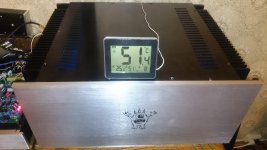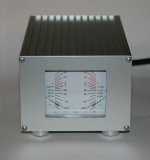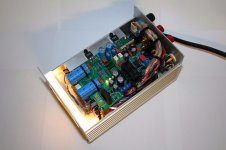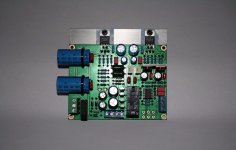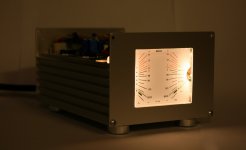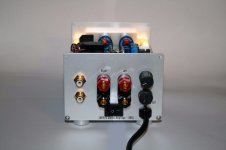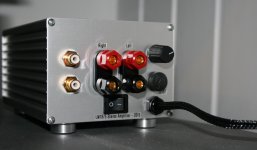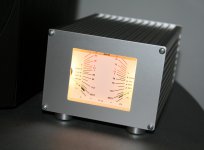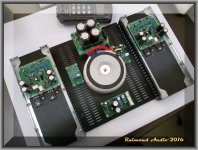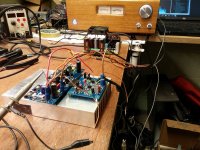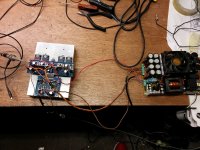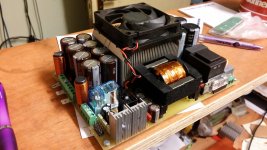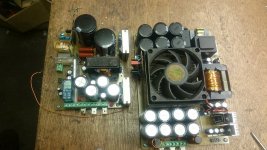Rebuilt my dual mono slewmaster with 21st century protection board. A lot of extra wiring, but It's nice to know that my amp and speakers are safe. 😉
Great build!
 Hope you like the control boards - this is the first build with two "21-st century protection..." boards per compartment 😀
Hope you like the control boards - this is the first build with two "21-st century protection..." boards per compartment 😀Rebuilt my dual mono slewmaster with 21st century protection board. A lot of extra wiring, but It's nice to know that my amp and speakers are safe. 😉
Is there bigger transformer hiding below that metal plate?
Thanks, I'm very happy with the boards, they worked perfectly on the first attempt.Great build!Hope you like the control boards - this is the first build with two "21-st century protection..." boards per compartment 😀
There's two 625va trannies below the plate. 😉Is there bigger transformer hiding below that metal plate?
80v rails.
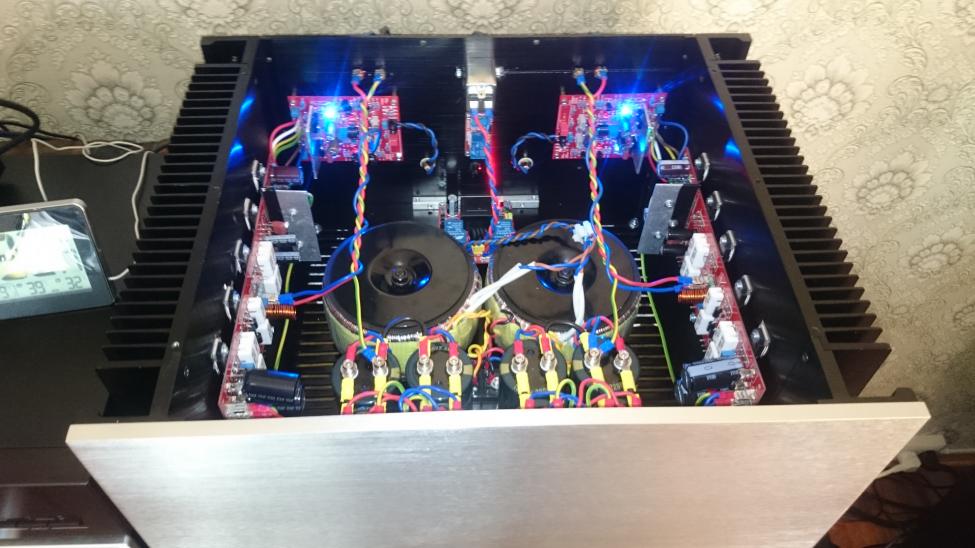
Wow, such a variety of nice project over here! Hereby some pictures of my humble and recently completed LM1875 gainclone 🙂. A blast from the past with those VU-meters that have been salvaged from an ancient Akai M01 cassette deck. The amplifier is quite compact and about 12 cm by 8 cm by 16 cm in size. I was quite surprised; although it 'only' delivers approximately 20W in an 8 ohm dummy, it is still able to produce a lot of 'slam'. I actually like those LM1875's A LOT! The PCB harbours a speaker protection circuit and a buffer circuit with an OPA2604. The aluminum profile to which the LM's are attached is in turn attached to the cabinet. Therewith heat can easily radiate away. I use the amplifier in a HT set-up in which it drives my center speaker.
Attachments
Hi Kaplaars,Wow, such a variety of nice project over here! Hereby some pictures of my humble and recently completed LM1875 gainclone 🙂. A blast from the past with those VU-meters that have been salvaged from an ancient Akai M01 cassette deck. The amplifier is quite compact and about 12 cm by 8 cm by 16 cm in size. I was quite surprised; although it 'only' delivers approximately 20W in an 8 ohm dummy, it is still able to produce a lot of 'slam'. I actually like those LM1875's A LOT! The PCB harbours a speaker protection circuit and a buffer circuit with an OPA2604. The aluminum profile to which the LM's are attached is in turn attached to the cabinet. Therewith heat can easily radiate away. I use the amplifier in a HT set-up in which it drives my center speaker.
That amp is stellar looking. Another great build! Excellent workmanship.
Rick
Wow, such a variety of nice project over here! Hereby some pictures of my humble and recently completed LM1875 gainclone 🙂. A blast from the past with those VU-meters that have been salvaged from an ancient Akai M01 cassette deck. The amplifier is quite compact and about 12 cm by 8 cm by 16 cm in size. I was quite surprised; although it 'only' delivers approximately 20W in an 8 ohm dummy, it is still able to produce a lot of 'slam'. I actually like those LM1875's A LOT! The PCB harbours a speaker protection circuit and a buffer circuit with an OPA2604. The aluminum profile to which the LM's are attached is in turn attached to the cabinet. Therewith heat can easily radiate away. I use the amplifier in a HT set-up in which it drives my center speaker.
looking very nice

Wow, such a variety of nice project over here! Hereby some pictures of my humble and recently completed LM1875 gainclone 🙂. A blast from the past with those VU-meters that have been salvaged from an ancient Akai M01 cassette deck. The amplifier is quite compact and about 12 cm by 8 cm by 16 cm in size. I was quite surprised; although it 'only' delivers approximately 20W in an 8 ohm dummy, it is still able to produce a lot of 'slam'. I actually like those LM1875's A LOT! The PCB harbours a speaker protection circuit and a buffer circuit with an OPA2604. The aluminum profile to which the LM's are attached is in turn attached to the cabinet. Therewith heat can easily radiate away. I use the amplifier in a HT set-up in which it drives my center speaker.
wow
man i love that look with killer 70's vu meters
well done
Looks fantastic ! I like the LM1875 too. It does give a lot of slam in spite of the low power !
I figured this is the perfect place to make my first post !
I have been slowly working on an amplifier I call the "big neighbor disturber" which is pretty much a soviet time amplfier rebuilt inside.

Here's some pics from various parts of its build process :
Simple hybrid output stages based on LM3886 with output buffer transistors (BD316 and BD317)






Whoops ^^
Not gonna do that again hahaha, it took 6 hours for the transformer to cool down to 60ºC hahahaha.
Heatsinks managed to top out at 90ºC, sadly didn't take a pic of that measurement. The capacitors aren't gonna appreciate that heat either 😛
Simple dedicated headphone output amp :

4580 opamp, stabilized +/-15V power supply, 2SB772+2SD882 output buffering and low enough gain that no headphones get blown out lol. I have to experiment with A class output but I doubt the massively increased power use is worth the probably inaudible increase in performance. There's also proper relay based protection on the output.
And that's the final progress so far :

Excuse the bad wiring in some areas, things subject to change will remain nasty until they are no longer subject to change 😛
As far as inners go, things left to add are speaker protection from transistor shortout and tone controls.
Taking care of the actual looks is low on the priorities list for now especially since I lack the tools and materials to actually do anything about the exterior.
I don't know what the distortion characteristics are like, there's nothing audible at low or very high output levels, clipping point is well above my speakers power handling capacity - absolute peak output is 50Vpp into 1.6ohm load which is enough to destroy my speakers lol.
-----
I rebuilt one other soviet amp for a customer during summer.

Here's some pics of the internals :


This particular amp uses MOS based input switching but those switches aren't ESD protected and they tend to blow out very often (and in that particular amp they were all dead) so I replaced all of them by relays.

Tiny LM3886 based outputs. The original bits were completely destroyed somehow so there was really no point trying to repair them. The guy also has small speakers and the heatsinks are small too so the LM3886 is more than enough ~

Here's a little bit of torturing going on, I was adjusting the display to match the clipping point so when you see the reds you know the amp has reached its limit.
Other misc things I did was replacing the opamps for ssomething much nicer and also added proper regulated +/-15V supply. The thing had just resistor dividers from main supply originally 😱
The person was really häppy with the results and I was sad to hand it over hahahaha.
I have been slowly working on an amplifier I call the "big neighbor disturber" which is pretty much a soviet time amplfier rebuilt inside.

Here's some pics from various parts of its build process :
Simple hybrid output stages based on LM3886 with output buffer transistors (BD316 and BD317)






Whoops ^^
Not gonna do that again hahaha, it took 6 hours for the transformer to cool down to 60ºC hahahaha.
Heatsinks managed to top out at 90ºC, sadly didn't take a pic of that measurement. The capacitors aren't gonna appreciate that heat either 😛
Simple dedicated headphone output amp :

4580 opamp, stabilized +/-15V power supply, 2SB772+2SD882 output buffering and low enough gain that no headphones get blown out lol. I have to experiment with A class output but I doubt the massively increased power use is worth the probably inaudible increase in performance. There's also proper relay based protection on the output.
And that's the final progress so far :

Excuse the bad wiring in some areas, things subject to change will remain nasty until they are no longer subject to change 😛
As far as inners go, things left to add are speaker protection from transistor shortout and tone controls.
Taking care of the actual looks is low on the priorities list for now especially since I lack the tools and materials to actually do anything about the exterior.
I don't know what the distortion characteristics are like, there's nothing audible at low or very high output levels, clipping point is well above my speakers power handling capacity - absolute peak output is 50Vpp into 1.6ohm load which is enough to destroy my speakers lol.
-----
I rebuilt one other soviet amp for a customer during summer.

Here's some pics of the internals :


This particular amp uses MOS based input switching but those switches aren't ESD protected and they tend to blow out very often (and in that particular amp they were all dead) so I replaced all of them by relays.

Tiny LM3886 based outputs. The original bits were completely destroyed somehow so there was really no point trying to repair them. The guy also has small speakers and the heatsinks are small too so the LM3886 is more than enough ~

Here's a little bit of torturing going on, I was adjusting the display to match the clipping point so when you see the reds you know the amp has reached its limit.
Other misc things I did was replacing the opamps for ssomething much nicer and also added proper regulated +/-15V supply. The thing had just resistor dividers from main supply originally 😱
The person was really häppy with the results and I was sad to hand it over hahahaha.
Pic's from the last year 😀.
Amplifier and PSU made from ATX + AMD rubbish hanging around my desk.
Happy New Year. May the force be with You in 2016 !
Nice PSU, is it your design?
Regards
apexaudio
Yes it is my PSU. It is made in 70-80% from the scrap. On the board is :
-standby 15V
-temperature protection
-over load protection/ short circuit protection
-+/-15V for preamp
-another 15V AUX supply
-speakers delayed ON
-speakers fast switch OFF
-DC protection
-temperature protection for amplifier
-auxilary SMPS switch OFF trigger can be added
There is smaller version too with LLC capability.
The main board is universal, any smps driver can be adopted to run it - like in slewmaster 🙂
slewSMPS 🙂
Regards
Yes it is my PSU. It is made in 70-80% from the scrap. On the board is :
-standby 15V
-temperature protection
-over load protection/ short circuit protection
-+/-15V for preamp
-another 15V AUX supply
-speakers delayed ON
-speakers fast switch OFF
-DC protection
-temperature protection for amplifier
-auxilary SMPS switch OFF trigger can be added
There is smaller version too with LLC capability.
The main board is universal, any smps driver can be adopted to run it - like in slewmaster 🙂
slewSMPS 🙂
Regards
Attachments
Last edited:
- Home
- Amplifiers
- Solid State
- Post your Solid State pics here
